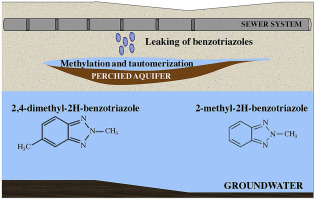Water Research ( IF 11.4 ) Pub Date : 2017-12-26 , DOI: 10.1016/j.watres.2017.12.036 Branka Trček , Dušan Žigon , Vlasta Kramarič Zidar , Primož Auersperger

|
Benzotriazoles (BTs) are considered as Contaminants of Emerging Concern (CECs); however, information about their fate in aquifers continues to be absent. This was the focus of the present study, which provides the first evidence for relevant BTs' degradation products (BTTPs) in urban aquifers that may impact the groundwater quality. The mechanisms and biotransformation pathways of BTs were investigated in an oxic intergranular medium. The BTs and BTTPs were identified and quantified by gas chromatography–mass spectrometry (GC–MS) and liquid chromatography–mass spectrometry (LC–MS) analytical techniques based on reference standards and internal materials. The major transformation products were identified as 2-methyl-2H-benzotriazole (2-MeBT) for the degradation of 1H-benzotriazole (BT) and as 2,4-dimethyl-2H-benzotriazole (2,4-dMeBT) and 1,4-dimethyl-1H-benzotriazole (1,4-dMeBT) for the degradation of 4-methyl-1H-benzotriazole (4-MeBT), and most probably also 5-methyl-1H-benzotriazole (5-MeBT). The leakage of wastewater pipelines is most probably the source of BTs. Sediments with a lower hydraulic conductivity give rise to perched aquifer conditions that lead to the temporal storage of leaking effluents and presumably the majority of BTs' transformation processes via methylation and tautomerization. The most stable BTTPs entered the saturated zone of the aquifer, where they prevailed. Concentrations up to 1500 ng L−1 were measured for the 2,4-dMeBT, which suggest a contamination risk for groundwater that is or may be used as a source for drinking water in the case of a constant input of pollutant loads from sewer systems.
中文翻译:

城市有氧颗粒间含水层中苯并三唑污染物的去向
苯并三唑(BTs)被视为新兴污染物(CEC);然而,关于它们在含水层中的命运的信息仍然缺乏。这是本研究的重点,它为可能影响地下水质量的城市含水层中相关BT的降解产物(BTTP)提供了第一个证据。在有氧颗粒间介质中研究了BTs的机理和生物转化途径。根据参考标准和内部材料,通过气相色谱-质谱法(GC-MS)和液相色谱-质谱法(LC-MS)的分析技术对BTs和BTTP进行了鉴定和定量。主要降解产物被确定为用于降解1H-苯并三唑(BT)的2-甲基-2H-苯并三唑(2-MeBT)和被鉴定为2,4-二甲基-2H-苯并三唑(2,4-dMeBT)和1,4-二甲基-1H-苯并三唑(1,4-dMeBT)用于降解4-甲基-1H-苯并三唑(4-MeBT),最有可能降解5-甲基-1H-苯并三唑(5-MeBT)。废水管道的泄漏很可能是BT的来源。具有较低水力传导率的沉积物会导致栖息的含水层条件,从而导致泄漏污水的临时储存,大概是大多数BTs通过甲基化和互变异构化的转化过程。最稳定的BTTP进入了含水层的饱和区,并在那里占了上风。浓度高达1500 ng L 具有较低水力传导率的沉积物会导致栖息的含水层条件,从而导致泄漏污水的临时储存,大概是大多数BTs通过甲基化和互变异构化的转化过程。最稳定的BTTP进入了含水层的饱和区,并在那里占了上风。浓度高达1500 ng L 具有较低水力传导率的沉积物会导致栖息的含水层条件,从而导致泄漏污水的临时储存,大概是大多数BTs通过甲基化和互变异构化的转化过程。最稳定的BTTP进入了含水层的饱和区,并在那里占了上风。浓度高达1500 ng L对2,4-dMeBT的测量结果为-1,这表明在污水系统不断输入污染物负荷的情况下,地下水有或可能被用作饮用水的污染风险。











































 京公网安备 11010802027423号
京公网安备 11010802027423号